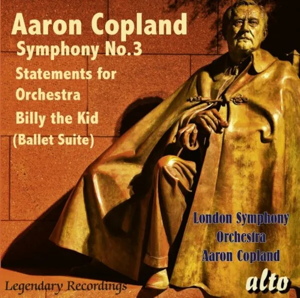
Aaron Copland (1900-1990)
Billy the Kid: Ballet Suite (1938)
Statements for Orchestra (1935)
Symphony No 3 (1946)
London Symphony Orchestra/Aaron Copland
rec. 1958-59, Walthamstow Assembly Hall, London
Legendary Recordings (Everest SDBR 3015 & 8)
Alto ALC1703 [78]
The disc begins with Billy the Kid: Ballet Suite. Aaron Copland wrote this evocative score for the Ballet Caravan at the behest of the American author and impresario Lincoln Kirstein. It was premiered in Chicago in October 1938. The following year, Copland made an orchestral suite, first heard at the Radio City, New York on 9 November 1940. The ballet tells Billy’s story: his childhood, life on the American frontier, turning to crime and death. The Suite presents six vignettes: The Open Prairie, Street in a Frontier Town, Card Game at Night, Gun Battle, Celebration after Billy’s Capture and The Open Prairie Again. Traditional folk tunes are moulded by Copland’s distinctive style. The music alternates between lively, rhythmic passages and more serene, atmospheric moments. It suggests the vast landscapes and vibrant spirit of the Wild West – at least in the imagination of Hollywood. The composer admitted that it was the “first time that I attempted to tap the rich source of American folk music and give it a full orchestral setting”.
The present recording was released in 1958 on the Everest label (SDBR 3015). The liner notes do not say that it was recorded in Walthamstow Assembly Hall, London, on 17 November 1958. Copland as conductor of the London Symphony Orchestra is subtle rather than overdoing the “rootin’ tootin’ and shootin’” inherent in the story.
The same LP contained Copland’s Statements for Orchestra, a commission by the League of Composers. The first two movements were premiered by the Minneapolis Symphony Orchestra under Eugene Ormandy on 9 January 1936. A full performance was not heard until 7 January 1942, by the New York Philharmonic, conducted by Dimitri Mitropoulos.
There are six brief movements with “suggestive titles” given as an aid to the understanding of what Copland had in mind. These abstract, dissonant, movements are Militant, Cryptic, Dogmatic, Subjective, Jingo and Prophetic. This is an exceptionally angular and effective performance of this work.
Copland wrote the Symphony No 3 between 1944 and 1946. It was commissioned by the Koussevitzky Music Foundation in honour of Serge Koussevitzky’s late wife. The symphony was premiered in 1946 by the Boston Symphony Orchestra under Koussevitzky. It is true to say that the symphony expresses the quintessential American sound Copland is known for. It blends expansive, lyrical melodies with powerful, rhythmic drive.
The Symphony has four movements; the final movement incorporates Copland’s famous Fanfare for the Common Man. The fanfare, originally composed in 1942, leads to a triumphant and optimistic conclusion to the symphony. Throughout, Copland’s rich orchestration and dynamic contrasts create a vibrant and expressive musical landscape.
Symphony No 3, often hailed as a representation of the “American spirit”, has become a staple in the orchestral repertoire. Like Appalachian Spring, it shows his ability to capture the essence of a nation through music. It is an often tender and always inspiring essay, with emotional depth and technical brilliance. The Symphony was recorded on 18 November 1958, once again at Walthamstow Assembly Hall, and released in 1959 on Everest SBDR 3018, in stereo.
Jeffrey Davis’s liner notes give a helpful introduction to this repertoire. They include several passages from Copland’s writings. Bearing in mind that these recordings are more than 67 years old, they are remarkable in depth and vivacity. At the time of the original vinyl releases, they were highly regarded technically.
I enjoyed these “historic” performances of Copland’s three important compositions. Conductors such as John Wilson, Leonard Slatkin, Leonard Bernstein and James Judd have turned their attention to some or all these works. Yet there is something special about a recording of a piece made by its creator. There is restraint and clarity, and a freshness and leanness, about these recordings that transcends time.
John France
Buying this recording via the link below generates revenue for MWI, which helps the site remain free.


















